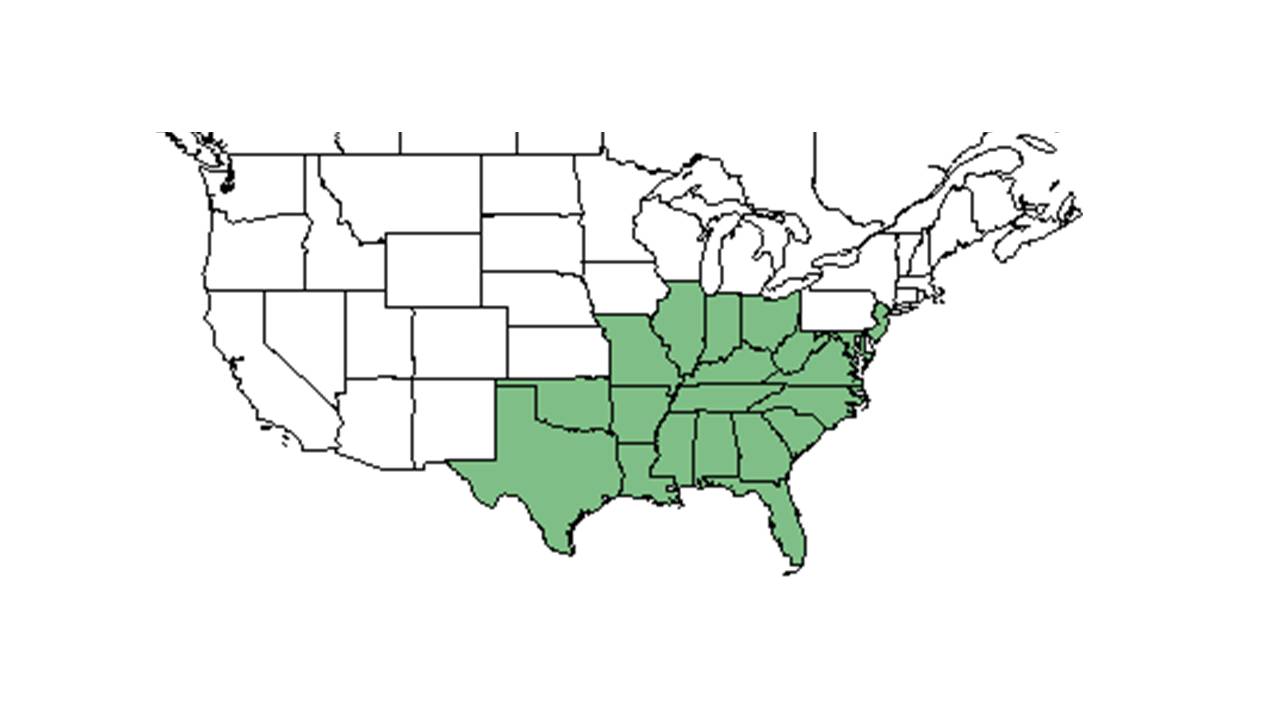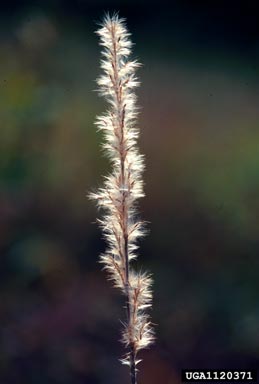Difference between revisions of "Erianthus alopecuroides"
| Line 33: | Line 33: | ||
==Ecology== | ==Ecology== | ||
===Habitat=== <!--Natural communities, human disturbed habitats, topography, hydrology, soils, light, fire regime requirements for removal of competition, etc.--> | ===Habitat=== <!--Natural communities, human disturbed habitats, topography, hydrology, soils, light, fire regime requirements for removal of competition, etc.--> | ||
| − | In the Coastal Plain in Florida and Georgia, ''E. alopecuroides'' can be found in longleaf pine forests, annually burned pinelands, fallow quail food patches, frequently burned mature longleaf pine-wiregrass communities, bordering wild plum thickets, pine-oak-hickory woods, mixed hardwood forests, and mesic woodlands. It can also be found along roadsides, cutover pineland clayhills, and powerline corridors. Soils include sandy loam, clayey soil, and loamy sand.<ref name=fsu>Florida State University Robert K. Godfrey Herbarium database. URL: http://herbarium.bio.fsu.edu. Last accessed: July 2015. Collectors: R. A. Norris, D. E. Powell, Robert K. Godfrey, Roy Komarek, Loran C. Anderson, Richard S. Mitchell, Andre F. Clewell, Travis MacClendon, B. Boothe, M. Boothe, K. MacClendon, Cindi Stewart, Annie Schmidt. States and Counties: Florida: Calhoun, Gadsden, Jackson, Jefferson, Leon, Liberty, Okaloosa, Wakulla. Georgia: Thomas. Compiled by Tall Timbers Research Station and Land Conservancy.</ref> | + | This species grows in roadsides, fields, and woodland borders.<ref name= "Weakley"/> In the Coastal Plain in Florida and Georgia, ''E. alopecuroides'' can be found in longleaf pine forests, annually burned pinelands, fallow quail food patches, frequently burned mature longleaf pine-wiregrass communities, bordering wild plum thickets, pine-oak-hickory woods, mixed hardwood forests, and mesic woodlands. It can also be found along roadsides, cutover pineland clayhills, and powerline corridors. Soils include sandy loam, clayey soil, and loamy sand.<ref name=fsu>Florida State University Robert K. Godfrey Herbarium database. URL: http://herbarium.bio.fsu.edu. Last accessed: July 2015. Collectors: R. A. Norris, D. E. Powell, Robert K. Godfrey, Roy Komarek, Loran C. Anderson, Richard S. Mitchell, Andre F. Clewell, Travis MacClendon, B. Boothe, M. Boothe, K. MacClendon, Cindi Stewart, Annie Schmidt. States and Counties: Florida: Calhoun, Gadsden, Jackson, Jefferson, Leon, Liberty, Okaloosa, Wakulla. Georgia: Thomas. Compiled by Tall Timbers Research Station and Land Conservancy.</ref> |
===Phenology=== <!--Timing off flowering, fruiting, seed dispersal, and environmental triggers. Cite PanFlora website if appropriate: http://www.gilnelson.com/PanFlora/ --> | ===Phenology=== <!--Timing off flowering, fruiting, seed dispersal, and environmental triggers. Cite PanFlora website if appropriate: http://www.gilnelson.com/PanFlora/ --> | ||
Revision as of 19:34, 8 May 2019
| Erianthus alopecuroides | |
|---|---|

| |
| Saccharum alopecuroidum (synonym shown); Photo by James H. Miller & Ted Bodner, Southern Weed Science Society, Bugwood.org | |
| Scientific classification | |
| Kingdom: | Plantae |
| Division: | Magnoliophyta – Flowering plants |
| Class: | Liliopsida – Monocotyledons |
| Order: | Cyperales |
| Family: | Poaceae ⁄ Gramineae |
| Genus: | Erianthus |
| Species: | E. alopecuroides |
| Binomial name | |
| Erianthus alopecuroides (L.) Nutt. | |

| |
| Natural range of Erianthus alopecuroides from USDA NRCS Plants Database. | |
Common name: Silver plumegrass
Contents
Taxonomic notes
Synonyms: Saccharum alopecuroides (Linnaeus) Nuttall; Saccharum alopecuroideum (Linnaeus) Nuttall; Erianthus divaricatus (Linnaeus) A.S. Hitchcock
Description
Erianthus are "coarse perennials from hardened bases or short rhizomes; culms usually purplish, nodes usually, glabrous or upper appressed pubescent, internodes usually glabrous. Leaves primarily cauline; blades scaberulous, usually densely long hirsute above ligule; sheaths usually glabrous; ligules membranous, ciliate, 1-4 mm long; collars long-hirsute. Panicle solitary, terminal, ovoid to ellipsoid. Racemes numerous, most ascending, joints and pedicels subequal, 2-6 mm long, scaberulous or villous. Spikelets in pairs, fertile, sessile and pedicellate, yellowish to purplish, ovoid. Glumes cartilaginous, acuminate, subequal; lemmas and paleas hyaline to purplish, shorter than glumes; callus usually bearded. Grain reddish, ellipsoid, 2-3.5 mm long."[1]
Specifically, Erianthus alopecuroides have "culms to 3 m tall. Blades to 7.5 dm long and 3 cm wide. Panicle whitish to tawny, 1.5-3 dm long, 5-12 cm broad; rachis long villous. Spikelets villous, 6-8 mm long, awns twisted, flat, 10-16 mm long; callus beard exceeding spikelet. Grain 2.5 mm long."[1]
Distribution
E. alopecuroides is generally distributed from New Jersey west to Indiana, Illinois, Missouri, and Oklahoma south to Florida and Texas.[2]
Ecology
Habitat
This species grows in roadsides, fields, and woodland borders.[2] In the Coastal Plain in Florida and Georgia, E. alopecuroides can be found in longleaf pine forests, annually burned pinelands, fallow quail food patches, frequently burned mature longleaf pine-wiregrass communities, bordering wild plum thickets, pine-oak-hickory woods, mixed hardwood forests, and mesic woodlands. It can also be found along roadsides, cutover pineland clayhills, and powerline corridors. Soils include sandy loam, clayey soil, and loamy sand.[3]
Phenology
This species generally flowers in October.[2] It has been observed to flower and fruit from September through November.[3]
Conservation and management
Cultivation and restoration
Photo Gallery
Plume of Saccharum alopecuroidum (synonym); Photo by James H. Miller, USDA Forest Service, Bugwood.org
References and notes
- ↑ 1.0 1.1 Radford, Albert E., Harry E. Ahles, and C. Ritchie Bell. Manual of the Vascular Flora of the Carolinas. 1964, 1968. The University of North Carolina Press. 160-1. Print.
- ↑ 2.0 2.1 2.2 Weakley, A. S. (2015). Flora of the Southern and Mid-Atlantic States. Chapel Hill, NC, University of North Carolina Herbarium.
- ↑ 3.0 3.1 Florida State University Robert K. Godfrey Herbarium database. URL: http://herbarium.bio.fsu.edu. Last accessed: July 2015. Collectors: R. A. Norris, D. E. Powell, Robert K. Godfrey, Roy Komarek, Loran C. Anderson, Richard S. Mitchell, Andre F. Clewell, Travis MacClendon, B. Boothe, M. Boothe, K. MacClendon, Cindi Stewart, Annie Schmidt. States and Counties: Florida: Calhoun, Gadsden, Jackson, Jefferson, Leon, Liberty, Okaloosa, Wakulla. Georgia: Thomas. Compiled by Tall Timbers Research Station and Land Conservancy.
